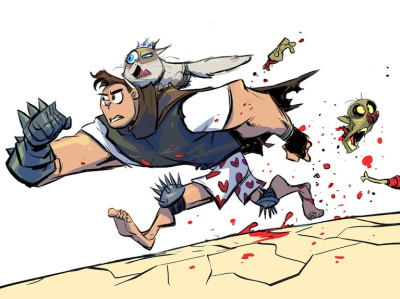
Showrooming (SHÅŒ-rÅ«m-iÅ‹) v. – 1. Going to a brick-and-mortar retailer to inspect a physical sample of an item one intends to buy online 2. Consulting a mobile device to compare prices while in a retail location, then buying online (or elsewhere) at a lower price.
On Tuesday, ICv2 reported that the graphic novel price war between Amazon and Overstock is likely to be a fixture of the retail landscape for the foreseeable future. Great news for consumers: lower prices! Good news for publishers: someone is challenging Amazon’s near-monopoly! But brick-and-mortar stores? Probably singing a song that goes "Doom, doom, doom do-doom."Online competition is nothing new to retail, of course. Amazon and its ilk have cut a swath of destruction through main streets and malls, affecting everything from books, music and DVDs to videogames and electronics. But the prospect of a price war between two well-resourced e-tailers, specifically around graphic novels and high-priced deluxe editions, can only seem ominous to comic shopkeepers when comparison shopping (and buying) is now as close as the ubiquitous smartphone.
This emerging consumer behavior trend, called "showrooming" by analysts (see definition above), is something I’ve been watching for a while as part of some broader work I’m doing on the future of marketing and retail. It’s not your imagination: this is really happening on a widespread basis, and it has already threatened brick and mortar sellers of electronics, tools, auto parts, kitchen equipment, and softline products where customers are looking for specialty items and shipping costs are relatively low.
The immediate concern for book and comic stories is that price competition in graphic novels between two volume-sized behemoths willing to lose millions to gain market share could squeeze the margins out of graphic novels altogether, depriving stores of a much-needed profit center. But the long-term problem is that expectations of lowest-possible prices online will change consumer behavior with respect to how they shop in retail stores.
Big brick-and-mortar retailers are terrified of this. Showrooming is blamed (or credited) with nearly destroying Best Buy last year. The big box electronics retailer only managed to bounce back through aggressive cost cutting, downsizing store locations, optimizing inventory, and enacting a price-matching policy that has at least partially neutralized the impact of instant online competition.
Sadly, few of those strategies are available to small, independently-owned comics and collectables retailers. However, geek culture businesses have some natural assets in this battle that can not only combat showrooming, but turn the trend into a net positive.
It’s the experience, stupid! First and foremost, comics retailers are not just selling comics; they are selling the experience of comics culture--and that experience is one of the hottest commodities on the market. The breakout success of just about every pop culture convention, from the mayhem that is San Diego to the smallest regional show, demonstrates that people crave the community that comes from sharing interests in an in-person, physical, social environment. They also happen to spend lots of money while they’re at it.
Granted, comic stores aren’t comic cons and often don’t have the resources to expand or renovate physical spaces built for an earlier, less demanding age of fandom. But store owners don’t need to become the Chamber of Commerce to get more community-focused, and they don’t need to empty the coffers on marketing to attract new customers. Comics culture is made up of supportive fans who don’t need much to activate their participation. That’s a huge advantage.
Here are some ideas I’ve heard for how stores can tap into some of the wider currents flowing through comics culture:
- Are there any creators in the area doing Kickstarters? Maybe host an event to connect them with potential fans and supporters. This not only supports artists and cool projects, but can bring lots of media attention--social and otherwise--to the store, because anyone doing a Kickstarter tends not to be shy about it.
- Is the local college offering a class in comics, as many are these days? Betcha the professor is a closet nerd and would love to help support the industry. I taught a class last year at University of Washington, gave my syllabus to my local comic store, and made sure all my students went there to buy assigned reading materials. Some of them ended up as regular customers.
- Stores that have the space to do gallery exhibits, singles nights and after-hours events can generate some added buzz that way. Those that don’t might be able to team up with local businesses to host a comics trivia night at a local bar or a cos-play event at the bowling alley.
Does your store sell runs of back issues packaged together in sets as a way to clear out old inventory? I’ve seen this a lot lately at retailers and cons, as well as on eBay. Why not take the next step and bind them into custom volumes?
Chances are there’s a commercial bindery in your area that does this for trade publications, small runs and craft items. The one near me seems to be able to make money doing basic library-bound editions of comics for $25-30 per volume. Retailers could probably drive a harder bargain based on a steady stream of business.
The result--a personalized, high-end, hardcover graphic novel that includes the original issues, including the ads and letter pages--compares favorably to a cheaply-printed trade paperback and can command a premium price. The binding process spoils the condition of the original comics, but how many comics from the last 25 years will ever be worth anything as collectables? And arguably, a handsomely-bound custom hardcover is even more desirable than a bagged-and-boarded floppy for run of the mill titles.
Best of all, as individualized craft items, custom bound editions are not available at any price on Amazon, Overstock, or anywhere. As an added benefit, embracing this business model positions retailers for a coming shift to custom print-on-demand--one possible direction that technology and distribution might be taking us.
If you can’t beat ‘em, join ‘em. One radical solution for retailers is to embrace the showroom concept: become a coffee shop or lounge that offers display copies of the latest titles and the means to order them online through some kind of affiliate storefront that rebates a portion of sales back to the originating business. I’d be shocked if we didn’t see Netflix, Amazon and maybe even comiXology cafés springing up along these lines in the next few years.
This hybrid model retains the human connection between publishers, retailers and customers--along with the social ambiance and trusted service and recommendations available at today’s brick and mortar locations, while surrendering non-strategic territory (inventory, logistics, ordering) to the efficiencies of online and centralized distribution.
Think different. The bottom line is that showrooming is primarily a threat to retailers that are not able to differentiate their experience, product lines or services, and thus become casualties of "Clash of the Titans" price wars.
Funky, small and idiosyncratic comics and pop culture retailers have ways to appeal to and engage their customers that are not available to cookie-cutter boutiques and big box warehouses, while targeting a consumer market much larger than typical niche craft shops.
Price-conscious customers will always look for--and find--better deals online. But just because prices are falling doesn’t mean the sky is too.
Rob Salkowitz (@robsalk) is author of Comic-Con and the Business of Pop Culture and is working on a new project on the future of marketing and retail in the digital age.
The opinions expressed in this column are solely those of the writer, and do not necessarily reflect the views of the editorial staff of ICv2.com.







